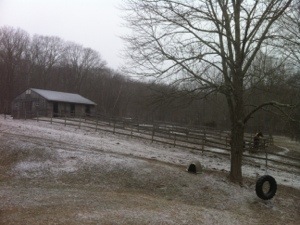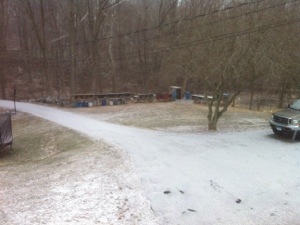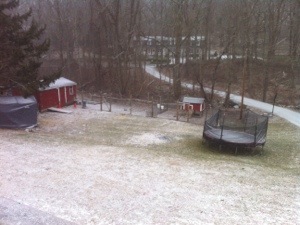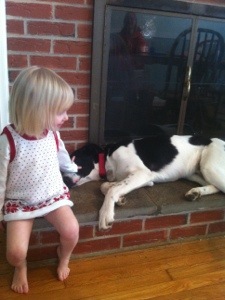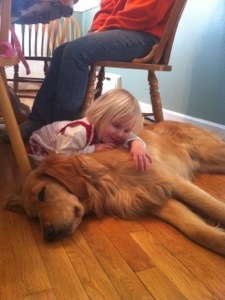Tonight we said goodbye to Dillon. Dillon was a 1yo Border Collie mix we took from a rescue just before Christmas. While he was very sweet, had good leash manners, and got along great with Mack, we were having problems. Dillon was getting aggressive with the horses, and had starting jumping at the faces of the ponies. Additionally, he was consistently running away whenever off leash. So, we talked to the rescue, and the wished for us to rehome him locally. After 2 weeks and a number of inappropriate candidates, we finally found what we hope will be a good home for Dillon. Mack might be a little depressed, but I think he will appreciate more focused attention from the family (the kids like him better).
Blizzard Feb 2013
Is it Nemo or Charlotte. Depends on tgr channel you watch. The name of the blizzard really doesn’t matter. We spent Thursday evening doing some extra prep for the storm, including loading extra hay into the horse barn. The snow started Friday morning just before 8. Within 15 minutes, the driveway way coated. Here are the Friday, 2/8/13 8am pictures.
By Friday afternoon, it had been snowing 6 hrs and we had 2-3″. We did the evening chores, first round of driveway plowing, and came inside. A rabbit was roasting in the oven and kids were playing Xbox when the power went out at 6pm. Definitely earlier than expected.
We changed dinner plans and moved all the bedding into the living room by the wood stove. Of course, it’s almost 75F in the living room, so I might have to change where I am sleeping.
Anna and I went out together to check on all the animals. They are all huddled up in shelters. We have somewhere between 12-16″ of snow already and it is blowing hard. The barn has drifts approaching 3′ against the East (windward) doors. The trees are VERY heavy with snow. We have branches leaning on the power lines to the house. Last I checked, North Stonington had over 1100 customers without power. We can run the generator in the morning to water the animals. I also might be using the Kubota to clear the driveway. The kids will probably appreciate if I pile all the snow in one spot.
Now the family is enjoying tea with water heated in a kettle on the wood stove. While I wouldn’t want to do this all the time, it is kind of cozy.
Life on the fringe
Anna and I frequently find ourselves “on the fringe” of society. What I mean by that is, we have moved away from much of what most Americans consider mainstream. Why? Primarily because the more we educate ourselves on decisions, the less we trust “corporate America”. While we are very confident in our choices, we are always willing to learn more. However, there must be actual factual background for choices and not just because it is what everyone else does. Here are some examples:
Goat milk. We chose to get dairy goats with the sole reason of using them for milk for our family. While the stats vary according to the source, in general, it is estimated that about 70% of the world’s population consumes goat milk. In the US, we drink goat milk, and we are on the fringe.
Raw milk. Not only is the milk we drink from a goat, it is UNPASTEURIZED! That’s right. We just filter and chill the milk. Do you think that the 70% of the world drinking goat milk have pasteurization machines in the kitchen? I completely understand why pasteurization exists – to cleanse milk of bacteria/contamination that is likely to be present on large-scale productions. However, it is very clear that unpasteurized milk can be safely produced and consumed on small-scale operations (like a family farm).
Raising our own meat. Our kids know the rabbits in the cages will be raised as meat. The chickens will give us eggs, and then they too will be dinner. You know what? They are not traumatized by this, because they don’t have illusions that meat comes from a mysterious factory in another place. Our children understand the life cycle better than some adults I have met. Choosing to raise meat, that isn’t injected with antibiotics, somehow puts us on the fringe. About 100 years ago we would have been considered normal.
Barefoot horses. Facts: horses in the wild do not have shoes, do not get trimmed by humans, do not exhibit many of the pathologies and hoof problems in domestic horses, and live longer. Yet, with all that reality, somehow Americans have become convinced that barefoot horses are the oddballs! I seriously have to defend the choice to leave shoes off or remove shoes from horses! Why don’t owners who have shod horses have to defend their choice since that is the unnatural path? Owning horses without metal plates nailed to hooves puts us on the fringe.
Rejecting chemical fertilizers. We choose to not use chemicals in our gardens, on our grass, in the pastures, or otherwise around the farm whenever possible. I’m not saying there is never a time and place for that, but we don’t feel the default choice should be a chemical. Organic practices put us on the fringe.
TV shows. There are some tv shows that I will not watch based on principle. I have never, and will never, watch American Idol, solely due to the name. I refuse to encourage or support the idolization of individuals in society. And yes, it extends way beyond tv. I heard there was a football game on tv yesterday. I didn’t watch it, because I am disappointed in the pedestal our society places professional athletes upon; the same athletes who are frequently poor role models.
Cooking. We (usually Anna but me too) cook food. I mean with actual ingredients. For example, Anna made cookies, and it didn’t involve a single box with 1 egg and water. Our kids look forward to special occasions because it means they might get to have a soda (there are none in the house). Dinner at a restaurant is exciting to the kids. McDonald’s is a rare treat. Sure, there are some quick and easy dinner options in the cabinet or freezer, but they are the exception around here. And by the way, we threw out all our non-stick and only cook in cast iron or stainless steel.
Church. We go to church regularly. This creates conflicts with horse shows, goa t shows, kid activities etc. People are surprised when you say Sunday morning is a conflict because you go to church. When did going to church become something for those on the fringe?
Don’t get me wrong, I’m not judging those who differ in opinions. I just can’t quite grasp how society seems to have shifted so much, that what was mainstream 100 years ago, has left us on the fringe…
Goat’s milk – by the numbers
Since our last doe has been dried up and we are getting ready for kidding season, I closed out the milk records for last season. If you are not familiar with the dairy industry, milk production is actually tracked and discussed by weight (pounds of milk), not volume. While it was obvious on a day-to-day basis what the production of the goats was, we decided last June to start tracking it for analysis (I am an engineer after all). So, after each milking, we would weigh the milk for the doe and record it on a sheet in the milking area. Then, at the end of the month, I entered the data into a spreadsheet.
This year, we had 4 goats in milk. We chose to only milk 1 time a day because it provided enough milk for us and reduced the chore load in the evenings. When we dropped to 1 time a day, we saw the daily total for each goat drop by about 30%. Lilly was sold shortly after starting the records, so she is excluded from the totals. Here is how the others did.
Saffron – Lamancha, first freshener. 283 days in milk. 840 lbs produced. 3.0lbs avg per day over entire cycle.
Tang – Lamancha, first freshener. 266 days in milk. 656 lbs produced. 2.5lbs avg per day over entire cycle.
Betty – Oberhasli, second freshener. 303 days in milk. 565 lbs produced. 1.9lbs avg per day over entire cycle.
Total for the 3 goats: 2061 lbs, or about 257 gallons. If we were purchasing raw cow milk, it would have a value of $2570. If we were purchasing raw goat milk, it would have a value of $5140. If we were purchasing the milk, we probably wouldn’t use as much as we do.
We had already observed that our Oberhasli’s don’t produce nearly as much as the Lamanchas. Therefore, if we decided to change to a single breed, it would be Lamanchas. Of course, we are not in this from a maximum production standpoint.
Conclusions. We use a lot of milk. It is cheaper to raise your own goats for milk than to buy milk.
It’s so cold…
2 degrees and 47% humidity this morning. Made it all the way into the teens during the day. How cold is it?
The eggs are freezing IN THE COOP! We keep feeding the frozen eggs to the dogs, so they are happy.
I spilled water on my jacket while watering rabbits. My jacket didn’t get wet because the water instantly froze on my sleeve.
I had a runny nose and ended up with snotcicles.
The horse poop is freezing to the ground from the moisture content. We need a shovel to break the pieces free.
My truck almost didn’t crank with the heater block plugged in!
I came in from doing chores and picked up some frozen meat to prep for dinner. It warmed my hands!
A new home for Milo
Next weekend, Milo will be leaving us to go to a new home. The young woman who will be taking him has more time for the training he needs. While we only had him about 2 months, we were able to make significant improvements on his hooves. I just hope they allow him to continue to heal without shoeing. He has also calmed a lot since we brought him home.
The reason we decided not to keep him is, we really don’t need multiple horses for adults and we have plenty of projects. If we are going to spend the money to keep extra horses, they need to be suitable for the kids to ride and grow with. Milo didn’t fit that requirement, so we found him a good home.
Family dogs
Ok, so it’s a concussion
Yesterday, during a trail ride, I got thrown off Calli. You can read about how it happened in Training Calli #2. Yesterday evening, I had a mild headache but no significant issues. This morning, my headache had shifted from the back of my head more towards the front. When I turned my head quickly to the side, it would make me a little dizzy/disoriented and I was having a little occasional nausea. So, I went to the Dr.
Diagnosis: concussion.
Recommendation: don’t get thrown off horses. Also sending me to get a rain CT scan to make sure there is no internal bleeding.
I am replacing my Tipperary helmet, even though I can’t see damage to the structure.
Every ride, every time. That is the name of a video in Pony Club about helmet safety and a mantra we live by on our farm. No one rides a horse at our place without a helmet. This is why.
Training Calli #2
This week, all the glorious snow melted, leaving nasty annoying MUD! We have been working on catching up on manure management (it’s amazing how much the snow hides) which always takes up more daylight than expected. This afternoon was set aside as a trail riding day. We had some friends come over with 3 of their horses, Alex rode Precious, Anna rode a guest horse, and I rode Calli. One of the friends rode Milo. Vicki was at a friend’s house, so Devil and King stayed behind. The ride turned out to be a lot shorter (distance wise) than expected, which I will explain below, but I was actually in the saddle for at least 45 minutes.
First the good. Calli was the lead horse for the whole ride. That is a significant step forward for her. There were 3 other horses in the group that she had never seen before. Usually, she is very nervous about unknown horses behind her. Today, she seemed agitated that we were not pushing the pace enough and definitely wasn’t afraid of the horses behind her. She did, however, make sure they knew not to travel too close by pinning her ears and swishing her tail.
Another big step for us was, I rode Calli without her Glove boots. We rode across gravel and she didn’t take a single soft step or try to avoid the pressure. While I am not quite satisfied with the concavity in her hooves and think she will continue to improve, I am very happy with the improvement so far.
Calli didn’t run away when I was unsaddled. Which, leads to the bad.
The bad. When we got out into a big open field, all the horses got nervous. In fact, Alex couldn’t get Precious to cross the boundary from the trail to the field. As I was watching Alex work through that with Precious, Calli started to focus on something across the field, probably 200+ yards away. I am guessing it was deer just in the edge of the woods. I didn’t see exactly what set them off, but I think Calli went first. She spooked and reared up. Since we were on a slope, I already had Calli standing uphill while I watched Alex. As Calli’s head came up, I came forward in the saddle to prevent pulling us over backwards on the hill (I have a history of King going over backward on top of me, so I think I over-react when I think the horse might go over backwards). The result was, Calli’s head slammed into my jaw, which stunned me severely enough that I didn’t have a chance of staying in the saddle. I recall trying to keep my seat, but I was just stunned enough that I couldn’t (like when a boxer gets hit on the jaw and slowly hits the mat). Of course, the ground provided another impact. I’m not exactly clear on how I hit, only that I think it was a left shoulder roll, into a lower back/tailbone impact, followed by a head slam. I wanted to jump right up and grab Calli, but I was still stunned and it took a minute. When I looked around, 3 other people were also dismounted, but it was because as all the other horses started to spook, they were able to emergency dismount and land on their feet. Calli didn’t run off, and stood quietly for me to remount. She looked a little confused about why I was off. I’m a little sore, but don’t think there is any significant damage.
2012 review, 2013 plans
First, Thank You to everyone who supported Sawyer Family Farm in 2012!
Last year was marked by significant growth and trying new things on the farm and we learned a lot. When we started our farm, it was with the intent to provide healthier food for our family, that we could trust was free of antibiotics, artificial hormones, injected juices, and all the other things that we don’t know about in the mainstream food supply. We are well on our way to achieving that goal. Frequently last summer, we were able to serve entire meals with items produced exclusively on our farm: meat, vegetables, and dairy products. We enjoy raising the animals, however, it is a lot of work (just ask our farm sitter who experienced the life for 10 days while we were gone at Christmas)! A frequent conversation starter at our house is “What do we enjoy, what do make money at, and what isn’t worth the money.”
So, here is a breakdown across the areas we tried out in 2012 and some of our 2013 plans.
Eggs: There is a constant demand for our eggs. We love the idea of having a cooler at the end of our driveway to sell fresh eggs to local neighbors, however, after losing around $100 in coolers, eggs, and money, we had to stop. We have been providing eggs to other groups such as Wesleyan University Food Co-op and for sale on CT Farm Fresh Express, however, our local customers come first, so if you still want our fresh eggs, give us a call. 2013: We will continue to have fresh eggs available, however, we will not expand our laying flock. NOTE: we are getting ready for chick hatching season soon, so eggs may not be quite as available as we set them aside for hatching.
Meat Chickens: Wow. I never expected so much demand for the meat chickens. We ended up selling almost half of what we planning to keep for ourselves, but that is ok, because we have been eating more rabbits. In 2012, we tried Freedom Rangers as a meat chicken and also raised more heritage roosters. While we didn’t raise any Cornish Cross, we did process them on a number of occasions for another farm. While the Cornish Cross get bigger, have more breast meat, and are ready in half the time, we have decided they WILL NOT be raised on our farm. Additionally, we will not raise the Freedom Rangers again. We have decided that we prefer chickens that move around, scratch the grass, and act like chickens, even if that means it takes longer to raise them at a slightly higher cost.
2013: We will still raise some chickens as meat birds. However, based on the time it takes to process when they are all ready (and our extremely busy weekend schedules), we will likely have a very limited number of chickens available for sale. These will be offered to previous customers first.
Chicks: We hatched a lot of chicks in 2012 on a continuous hatching plan. This year, are going to try a very different approach. Stand by for an update on this within the next week.
Turkeys: Turkeys are stupid. That’s all there is too it. While we did get excellent feedback, we haven’t decided if the turkeys are worth the trouble. It was definitely more stressful than I anticipated as we approached Thanksgiving and realized many of the birds were going to be smaller than expected. We haven’t decided what future turkeys will have on the farm, however, we are committed to the heritage breeds if we raise them again.
Rabbits: This has to be one of the more frustrating areas of the farm. The rabbits are easier to care for than the chickens, easier to breed year round, and require less work. However, due to the feed costs, they are more expensive, which I think is negatively impacting our ability to sell more rabbits. Additionally, since rabbit isn’t a mainstream food source in the US, many are reluctant to try it. Rabbits are not going away (in fact we would really like to expand). We have a few ideas about what we might be able to do in order to lower costs for feeding. Stand by for a new project announcement in the near future.
Goats: We love the goats. They are just fun. The human kids enjoyed showing last summer at the North Stonington Fair, and this year, in 4-H, they will show goats a little more. Last summer, we used the milk to drink (a lot), make ice cream, and make soft cheese until we got tired of goat cheese and wine (which takes about 3 months, every evening after the human kids go to bed). Right now we have 9 does that we think are all bred. Kidding season starts in February and continues into early June. We haven’t completely decided on how large our dairy herd will be in the future, however, we do plan to sell a lot of kids (goat version only). Anna has grand plans to make hard cheeses (as soon as I buy or build a press) and soaps. That’s right, we will be selling Goat’s Milk soap and other skin care products in 2013.
Beef: We didn’t do anything with raising beef in 2012. However, we did by half a veal calf from some friends who also raise goats, and the meat was fabulous. We got 40lbs of meat from our half calf. Our plan is, buy a bob calf (male dairy calf) at less than a week old. Switch it over to goat milk and raise it for 2-3 months. The calf will live with the goats and be raised on milk and hay – no grains. We will pre-sell the calves as a whole or half calf and you pick up your meat at the butcher. More info and pricing will be available in the future, however this will be a very limited commodity.
Horses: Anna has been teaching some lessons. She is very good at it, even if she doesn’t believe that herself. At dinner the other night, Alex even stated his favorite riding instructor was his Mom! This year, we expect to continue to expand our horse involvement as the kids are more active in Pony Club and Anna and I try to riding more hunter paces for ourselves. We became dealers for a number of horse care products, primarily as associated with my trimming work. Horses have always been our first passion, and we are always challenged to make time for that as the other activities on the farm grow.
2013 resolutions:
Stay true to heritage breeds.
Continue to find efficiencies on farm.
Reduce reliance on commercial feed.
Have fun.

